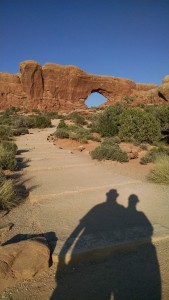By the numbers:
- 345 miles from Tremonton, UT to Moab, UT– 1390 total miles
- highest temp: 103.
- highest elevation: 5666 feet at Timpanogos Cave
- 1 state : Utah. Total for the trip: 4
- Licence plates spotted: 6 new states and provinces – 34 total for the trip
- 3 new National Park sites: Timpanogos Cave, Arches National Park, and Old Spanish National Historic Trail – 9 parks total for the trip.
- We decided not to do the actual cave tour on this trip but will definitely be back. The geology of cave formation and trying to get my head around the 100’s of thousands of years long process of their creation has always fascinated me. Visiting Jewell Cave in the Black Hills was one of my first visits to a national park and has stuck with me ever since.

- Even though I have seen many pictures of Arches National Park, none of them compare to actually being there. I have a bit of an issue with switchback, hang on the side of the mountain, type roads, and you had to travel a bit of that to get into the park. However, it wasn’t at all bad for me and, once inside, well worth the travel. We spent a few hours in the park and walked a couple of short paths but will have to come back for a longer stay.
-

At the end of the day we found a great restaurant, the Broken Oar (if you ever go, ask for Trisha as your waitress). Excellent food in a nice rustic decor. As a bonus, it was a short walk from the hotel. More importantly a short walk back to the hotel. Nice not to have to get back in the car after a long day driving.
The recent parks we have visited have caused me to reflect on how many of my greatest interests in the world relate to the wonder of Evolution. At Arches the park film used a phrase that really struck me. In stating that we often think of arches built by people and in comparing them to the arches in the park they said: One type is the result of Intentional Creation and the other the result of Erosive Destruction, but at least for a moment in time they look the same. Arches park has more natural arches than any other place on earth. They emphasized that this statement can only be made for this specific time because all the arches are like living things. Erosion slowly forms them and then slowly destroys them. Some arches here today will not be here in 100 or a 1000 years. New ones will be.
Having triggered this line of thought I found myself refelecting on several of the areas of scientific, historical, and cultural understanding which I find fascinating and about which I am always interested in learning more.
- Astronomy and the evolution of the universe, our galaxy and our solar system;
- Geology and the evolution of the physical nature of our planet;
- Evolutionary biology and the history of life on this planet;
- History and particularly the evolutionary history of human ideas about how we can and should live together and interact with each other;
- and more specifically the history of humanity’s thinking about civil rights, human rights and what we currently refer to as race relations. I hope and believe we, as a people, will get to a better place in our understanding of these issues. One small step might be the current effort to eliminate the use of the Confederate Flag in an official manner in South Carolina after the recent shooting there.
- Our personal ancestral history and development. The part of my ongoing ancestry and family history research I love the most is developing a better understanding of where my ancestors lived, what circumstances they had to deal with in their lives, what traits and skills enabled them to survive and what events caused them to relocated to new places.
- In short, I have always been fascinated with the process of things. Where did things start from? How did and do they evolve into something else? What happened along the way?